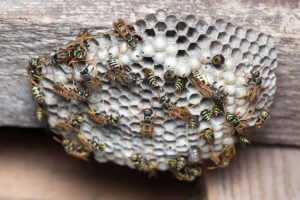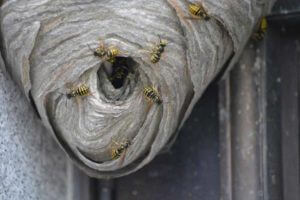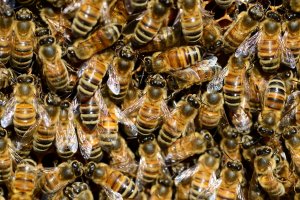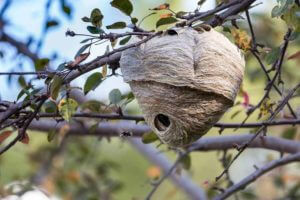Contrary to popular belief, there is a variety of species of common flies. In fact, there are over 20,000 in North America alone! While we’d thoroughly enjoy discussing the differences between all of the fly species, we wanted to focus on the two we deal with most regularly— the house fly and the cluster fly.
House Flies
The house fly is by far one of the most common pests we find in and around homes. It has a worldwide distribution and is extremely prominent throughout the US. We consider these insects to be not only nuisance pests while buzzing in and around homes— but they also have the potential to carry diseases. They have relatively brief lifespans; however, they have the ability to quickly reproduce in numbers, leading to large house fly populations if not properly identified and effectively controlled.
House flies are usually grey in color and have four black stripes on their thorax. Adults are about 1/8-1/4 inches long. They have slightly hairy bodies, a single pair of wings and compound red eyes, which contain thousands of individual lenses that give them broader vision. Female house flies are usually larger in size than males and they do not have teeth or a stinger.
Housefly eggs closely resemble grains of rice; these eggs will hatch into larvae, or maggots, that range in size from about ¼-3/8” long. Maggots are cream in color and appear to be greasy. When entering the pupal stage, maggots become dark and develop hard outer shells, as well as legs and wings, ultimately emerging as full-grown adult flies.
Signs of an infestation
The most common sign of a housefly infestation is the physical presence of the flies themselves. You may also see larvae crawling out of their breeding material as they pupate. Along with seeing the insects, people may hear them around the home. House flies produce buzzing sounds which are a result of their two wings beating together.
If you suspect to have a house fly infestation in your home, it is important to contact a licensed pest control professional in order to conduct a proper inspection, specifically looking for any places where house fly eggs deposit. Since house flies enter from the outdoors, internal breeding sites are uncommon. However, garbage rooms and trash compactors provide an ideal environment for house fly breeding and should be routinely checked. If the breeding site(s) are not thoroughly cleaned or removed, the problems with these pests will persist.
Once the breeding site has been remediated, eliminating the existing adult flies is the next step. A pest control professional will develop a treatment plan based on the circumstances of the infestation; this may include the use of fly bait, applications, or traps.
To prevent a house fly infestation from occurring in the first place, vigilant and constant sanitation is a necessity. Regularly removing trash and using adequately sealed garbage receptacles can help to deter any house flies from residing around waste bins. Additionally, pet waste must be taken care of immediately to prevent the development of any further breeding sites. Finally, all doors and windows should have fine mesh screens in order to avoid house flies from entering the home. If screens are already present, make sure there are no visible rips or tears.
Cluster Flies
Cluster flies, on the other hand, are slightly larger and thinner than house flies at 3/8 of an inch in size. They are a dull grey in color (not metallic like some other fly species) with golden hairs on the thorax and a grey checkerboard pattern on the abdomen. When resting, their wings usually overlap over their backs. If you crush cluster flies they may smell sweet, like honey!
These flies have a unique life cycle. The larvae live in soil where they are internal parasites of earthworms. Consequently, structures with large lawns or those near fields are more likely to have problems with overwintering cluster flies. There are four generations a year, but we only consider the late-season adults as pests as they move inside structures in late summer or fall. Adults feed on flowers and are not attracted to garbage, feces or dead animals.
Cluster flies are slow-moving, especially when they become active indoors on warm winter days (when the heat fluctuates) or in early spring as they look for a way outside. They head for light and often end up clustered around windows or in ceiling light fixtures.
We can control cluster flies by creating barriers in mid-to-late-summer to prevent their entry: treatment of the exterior with a repellent residual, as well as pest-proofing of openings, especially around the roofline. It’s critical to time the residual application before fly entry in your area.
Once the flies are inside, control is difficult, and results are often disappointing. Avoid killing them in inaccessible voids because the dead flies can attract beetles. Vacuuming, sticky traps, and light traps can remove wandering flies.
Signs of an infestation
During the cold winter months, cluster flies often congregate around windows or doors on warm days or when the heat is increased, prompting frantic calls for service. Controlling cluster flies indoors can be difficult as populations are frequently hiding in hard-to-reach voids or attics. Indoor insecticide applications are often impractical and result in large numbers of dead flies that are attractive to secondary pests such as carpet beetles. Usually, exclusion is the best solution but should be complete by the early autumn, before the insects make their way indoors.
Completely sealing every entry point is difficult, especially because cluster flies enter near the roofline through soffit or ridge vents. Exterior surface applications of appropriate repellent insecticides can be helpful in deterring them, but applications should be made before aggregations of flies begin to appear on the building. In many cases, we instruct clients to vacuum any carcasses popping up in homes.
No matter the fly, Hogarth’s Pest Control and Wildlife Removal has the skillset to not only curb an infestation but the necessary exclusion and clean-up work required to keep any home fly-free. If you have noticed an issue with house or cluster flies in your home or business, please give us a call. We have been keeping Northern Michigan homes free of these pests for 25 years!



